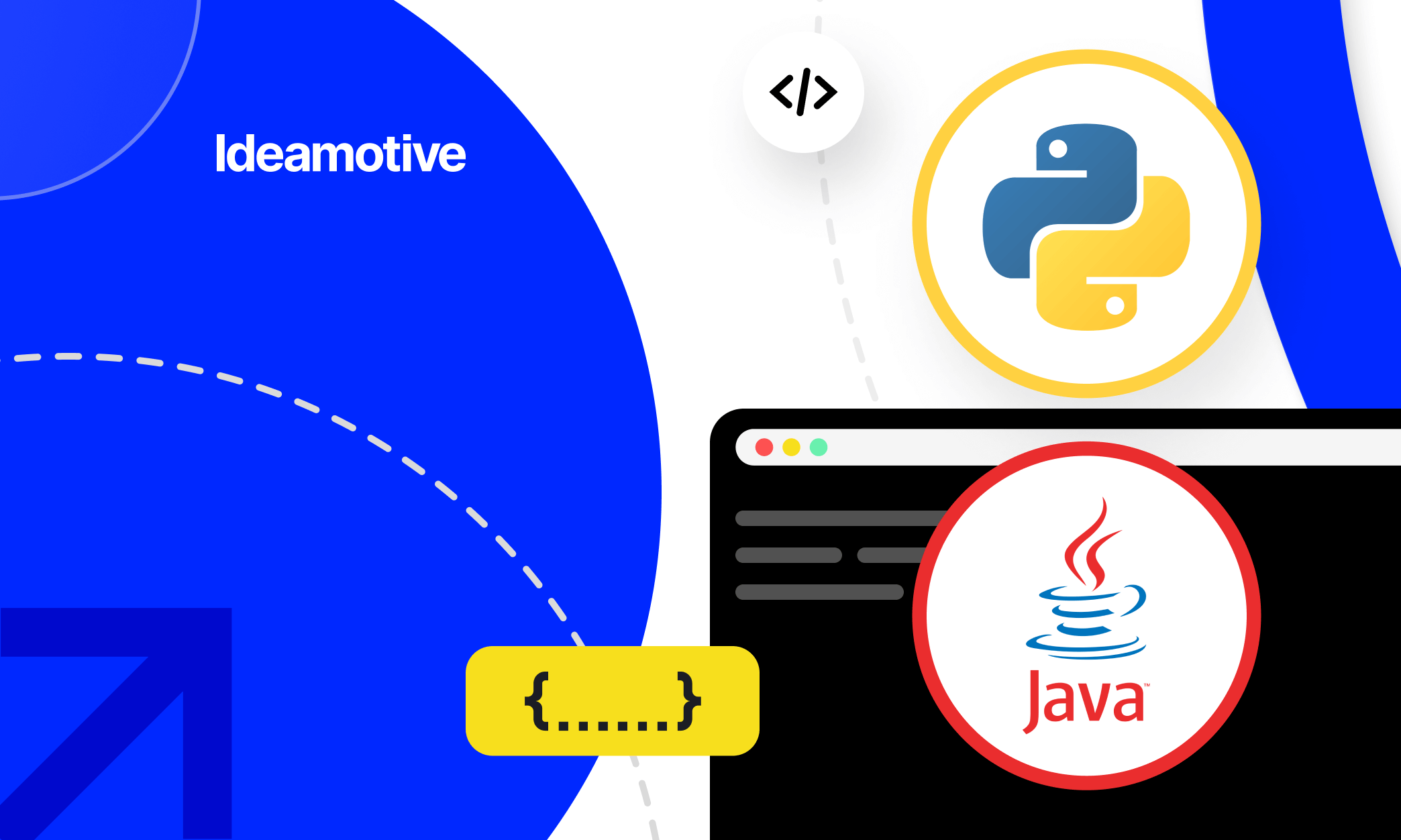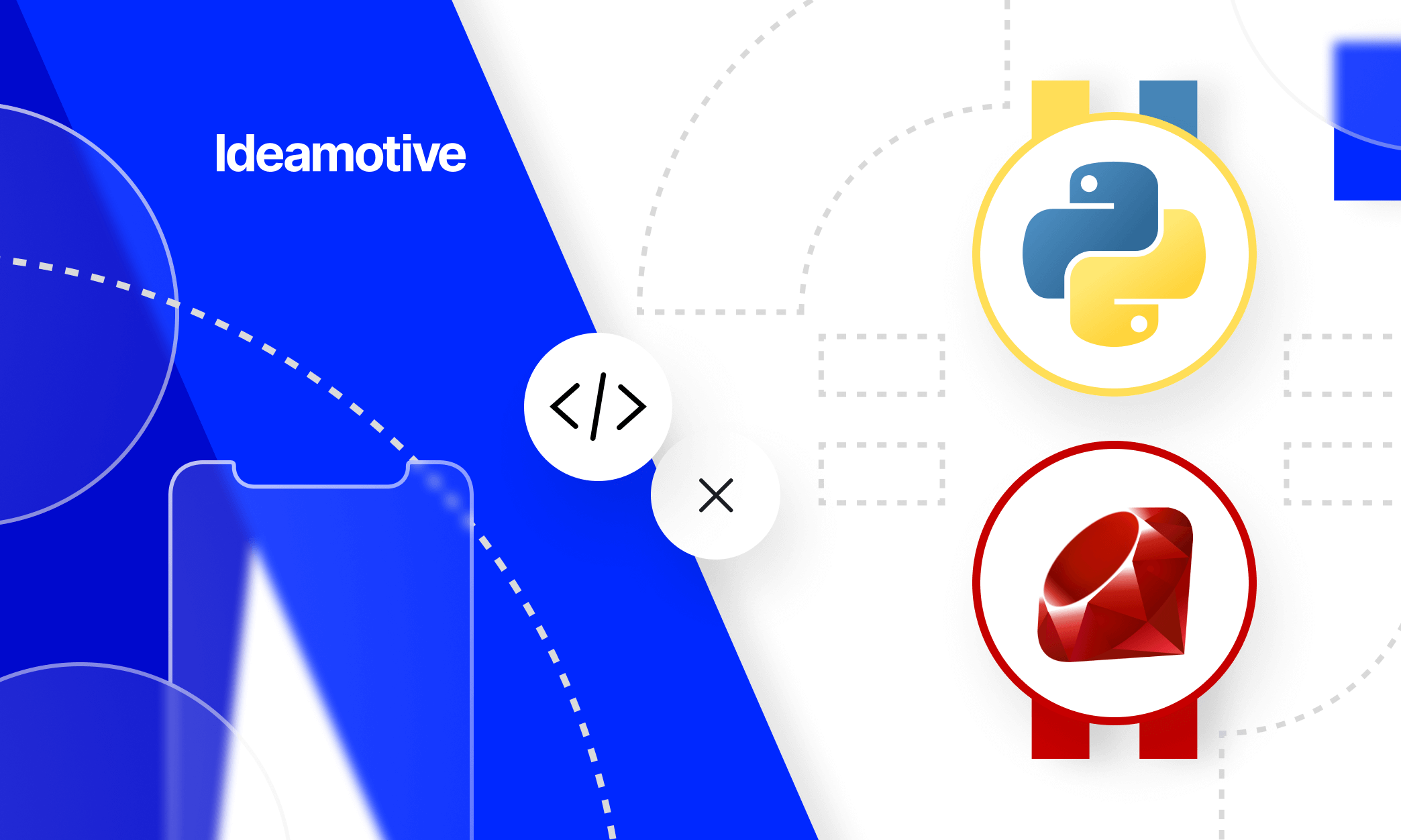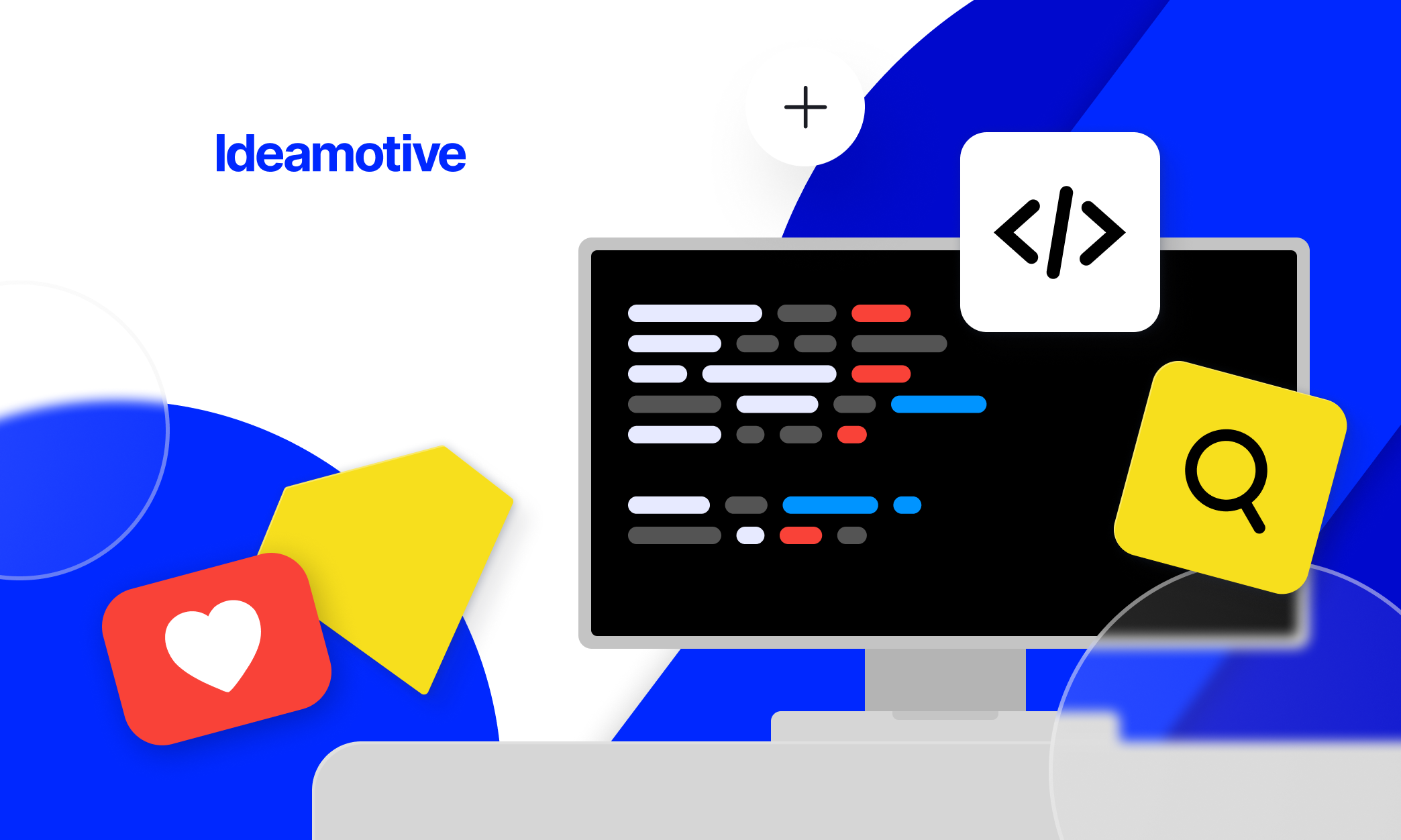Python vs JavaScript: Which Is Better For Machine Learning Project?
Apr 2, 20209 min read

Michał Pruciak
Michał is a highly skilled Business Development Manager with a passion for the intersection of medical technology and cutting-edge technology. When he's not working, Michał can often be found enjoying a good movie or hitting the trails for a hike.

Machine intelligence has rapidly moved from experimental to applied technology, and the level of its adoption is growing steadily, also among small and medium businesses. 2022 is poised to be a landmark year for the development of AI and machine learning solutions, so it’s the right moment to tap into the unique opportunities they present.
According to industry research, while enterprises invest in ML primarily to reduce costs and reduce manual work, startups and small businesses harness the technology mainly to enhance customer-facing functions and gather insights that allow them to refine services, increase customer satisfaction and retention, and gain a competitive edge. Those benefits of machine learning (for more, see our free guide to AI) are up for grabs for your business, too.
The best way to launch a machine learning project is to start small. First, you need to choose the programming language that’s the most suitable for the implementation of your idea. This decision will impact key considerations of your project, such as cost, resources, and time. To help you, we look into two popular choices when it comes to machine learning, namely Python and JavaScript. Let’s see how they fare against each other.
What Is JavaScript?
JavaScript (JS) consistently ranks first as the most widely-used programming language among developers. It is an industry-standard frontend scripting language that’s best suited for making static websites dynamic, which cannot be attained with standard HTML and CSS. What this means is that when an object on a website, for example, a button, is created in HTML, JavaScript makes it possible to animate it and interact with it. Because of its common application in web development, JavaScript is everywhere, to the point that it comes built-in in all web browsers, and doesn’t require downloading any compilers or extra software.
Examples of JavaScript: When you are liking a friend’s post on Facebook, scrolling photos on Instagram, or using your social credentials to log in to a portal, that’s JavaScript standing behind those features.
Can JavaScript Be Used For Machine Learning?
So, can JavaScript be used for machine learning? The short answer is ‘Yes.’ However, the real question should be, whether it’s the most suitable choice for ML applications.
When implementing a machine learning project, a few significant factors come into play. First of all, the number of available code libraries, so pre-existing sets of code routines that may be reused in different applications. The more of them are available, the more streamlined the implementation.
While most JavaScript machine learning libraries are quite recent, especially when compared to Python, they are advanced enough to power some significant ML use cases. What’s more, new ones are continuously being added, focusing especially on computational data, data analysis pipeline (e.g., data generation), and performance optimization. In this context, it’s also important to mention that frontend JS machine learning libraries are usually applied for existing, pre-trained models because of the computational costs while training new ML models is done in backends like Node.js
The second important factor in favor of this scripting language is community support, which often proves essential, especially in complex or pioneering projects. The JavaScript ecosystem of over 10 million developers is constantly adding and evolving JS libraries that make the implementation of ML algorithms and neural networks much easier.
Examples of JavaScript Applications in Machine Learning
As mentioned above, JavaScript is primarily used for creating dynamic web pages. Therefore, its application in machine learning is mostly related to running ML models in web browsers (for example, to create an app that allows devices to recognize and identify objects appearing in the camera). One important feature of JavaScript that makes it suitable for some ML projects is the fact that it can run on most platforms and device types, lessening compatibility issues.
A popular open-source library that enables the deployment of machine learning programs in the browser is TensorFlow.js. It allows running existing models in the browser, training ready models with your own data, and developing new machine learning models directly in the browser. Another commonly used library is Brain, which enables the creation and training of neural networks and loading them onto a browser, e.g., to recognize color contrast.
Other prominent examples of using this object-oriented programming language in ML are as follows:
Deep playground
An educational web app that lets you play with neural networks and learn about their various components. It has a nice user interface that allows you to control the inputs, the number of neurons, which algorithm to use, and various other metrics that will be reflected in the end result. There's also a lot to learn from the app behind the scenes - the code is open source and uses a custom machine learning library written in TypeScript and well-documented.
FlappyLearning
FlappyLearning is a JavaScript project that builds a machine learning library out of about 800 lines of raw code and implements it in a fun demo that learns how to play Flappy Bird like a virtuoso. The artificial intelligence technique used in this library is called Neuroevolution and applies algorithms inspired by the natural nervous system, dynamically extracting from the success or failure of each iteration. The demo is very easy to run - just open index.html in a browser.
Synaptic
Probably the most actively supported project on this list, Synaptic is an architecture agnostic Node.js and browser library, allowing developers to build whatever type of neural networks they want. It has several built-in architectures, allowing you to quickly test and compare different machine learning algorithms. It also has a well-written introduction to neural networks, a number of hands-on demos, and many other great tutorials that uncover myths about how machine learning works.
Land Lines
Land Lines is an interesting Chrome web experiment that finds satellite images of the Earth similar to those drawn by the user. The application does not talk to the server: it runs entirely in a browser and, thanks to the clever use of machine learning and WebGL, has excellent performance even on mobile devices. You can check out the source code on GitHub or read the full example here.
ConvNetJS
Although ConvNetJS is no longer actively supported, it is one of the most advanced deep learning libraries for JavaScript. Originally developed at Stanford University, ConvNetJS has become quite popular on GitHub, resulting in many features and community guides. It works directly in the browser, supports several training methods, and is quite low-level, which makes it suitable for people with a lot of experience in neural networks.
Thing Translator
Thing Translator is a web experiment that allows your phone to recognize real objects and give them names in different languages. The app is completely web-based and uses two machine learning APIs from Google - Cloud Vision for image recognition and Translate API for natural language translations.
Neurojs
A framework for building AI systems based on reinforcement learning. Unfortunately, the open-source project doesn't have proper documentation, but one of the demos, the self-driving car experiment, has a great description of the various parts that make up the neural network. The library is written in pure JavaScript and built using modern tools such as webpack and babel.
Machine_learning
Another library that allows us to configure and train neural networks using only JavaScript. It is very easy to install both in Node.js and on the client-side, and it has a very clean API that will be convenient for developers of all skill levels. The library provides many examples that implement popular algorithms to help you understand the basic principles of machine learning.
DeepForge
DeepForge is a user-friendly development environment for working with deep learning. It allows you to build neural networks with a simple GUI, supports training models on remote machines, and has built-in version control. The project runs in a browser and is based on Node.js and MongoDB, making the installation process familiar to most web developers.
What Is Python?
While it is not as widespread as JavaScript, Python is one of the fastest-growing programming languages in the world, surpassing Java, C#, and Ruby, and one of the developers’ favorites. It is widely used in a range of applications, from GUI-based desktop and web applications, through business solutions, up to data analysis engines.
Python is an open-source, general-purpose object-oriented programming language, praised for high readability, productivity, and speed. Python is often used as a main backend language or an extension language for web applications written in other languages, and it is also a frequent choice when it comes to the development of automation, data mining, and machine learning platforms.
Examples of Python: Python is one of the official server-side languages used by Google; it is also used inside Instagram and Facebook infrastructures. Also, Quora, Netflix, and Spotify use it extensively, mainly to power their data analysis capabilities and backend services.
The next question - why Python is used for machine learning?
Is Python The Best For Machine Learning?
AI and machine learning development are fast-progressing, and there’s no shortage of their innovative applications in business. Some prominent examples include image classifiers, social media sentiment analytics, chatbots, predictive engines, or personalized recommendations (look here for more examples). To implement these tools and functionalities, data scientists, programmers and DevOps use a combination of programming languages, Python included.
So, is Python the best language for machine learning? For years, Python has been the language of choice for ML implementations. It provides a comprehensive library of packages with in-built functions that facilitate data analysis and processing, cleansing, modeling, visualization, and so on. These include TensorFlow, Keras, and Theano, all of which make it easy to implement various machine learning features. Many developers consider Python the preferred language for ML projects also because of its capability of interacting with other languages and platforms, and robust data handling capacity.
From a business standpoint, Python is used for machine learning projects for several reasons. First of all, it’s highly productive thanks to its design and has a ton of ready to use packages, which positively impacts the speed of implementation. Secondly, Python has a large community of developers and supporters. It’s estimated that there are more than 8 million Python coders around the world. This makes it easier to find people with the right skills to launch the project quickly. The extensive community support also enables daily code enhancements and regular creation of new libraries and packages that further accelerate the pace of development.
Python and JavaScript comparison
Speed of development
JS takes more time than Python, although both Python and JavaScript are dynamically typed, easy to learn syntax, and with a few built-in functions. Python is generally better than JavaScript in terms of speedy development, because it is simpler and easier to use.
Winner: Python
Versatility
Both languages have their pros and cons when it comes to versatility. While both languages are widely used in ERP and web development, Python is increasingly being used in emerging areas such as data analytics, AI (artificial intelligence), and ML (machine learning). It is also more used in areas such as Finance/Fintech to collect data useful in this area.
If you want to eventually delve deeper into any of these areas, leveraging Python is a much better option. On the other hand, JavaScript has the advantage of being both a front-end and a server-side language. Python is basically a back end limited language.
Winner: Python
Documentation
This question is especially important if you come across a difficult situation/question/issue. You need to choose a language that is relatively easy to use and has better documentation to find solutions if required. At this point, Python is much better than JavaScript. It is designed to be as beginner friendly as possible and uses simple variables and functions. JavaScript is full of complexities like class definitions. When it comes to ease of learning, Python is the clear winner.
However, due to a significant popularity, both Python and JavaScript are well documented, while also having a broad variety of forums and other sources to seek help in.
Winner: Python
Popularity
According to the 2021 Developer Survey, JavaScript continues to be the leading programming language. However, Python's popularity has also grown significantly over the past couple of years, beating languages such as Java, C#, PHP, and C++.
JavaScript web frameworks are also in the lead: jQuery, React.js, and Angular.js are among the top three most popular web frameworks. We also see some Python frameworks in this list: Django and Flask.
Another interesting aspect of this review is that Python is the third most popular language.
Winner: JavaScript
Community and talent pool
Given the data above, we can see that both Python and JavaScript are on top. Hence, both communities can’t complain about the lack of manpower in their ranks.
Python is now the fastest growing programming language, with developers earning about $116K (average salary). JavaScript programmers are not far behind: they make about 110 thousand dollars a year. So the battle between Python and JavaScript depends on your goals, since they are similar in terms of salary and quantity of devs available to help you.
Draw
Python vs. JavaScript: Questions to Ask Before You Choose
The selection of the right programming language is the first step to the implementation of any machine learning project. Therefore, if you cannot choose between Python vs. JavaScript, here a few questions that may ease your way into the decision:
- What is your app or model supposed to do? What environment will it run on? For example, if models leveraged by your application are to be frequently and extensively used, you might want to apply a JavaScript in-browser ML solution to lessen the cost of servers. If your specific ML problem has been already solved with Python, it will probably make more sense to use it instead to deliver your solution faster.
- What is your existing technology stack? Which frameworks are your teams using? Aligning the programming language with the existing technology stack usually leads to faster and more streamlined development. Choose a language that best matches your current technology capabilities.
- Are there any specific libraries and tools that are industry-standard or readily available? Python offers more data science packages and built-in functions, so the implementation may be a bit faster than in JS. However, new libraries for JavaScript are constantly emerging. For some usages, the language offers a mature and extensive catalog of tools that enable smooth development.
- Do your developers know the language? How fast can you hire experts if external support is required? In the case of JavaScript and Python, this isn’t that much of an issue, as they belong to the world’s most popular programming languages. However, remember that data science projects have their own special requirements. To avoid bottlenecks in project implementation, hire only pre-vetted teams of developers who combine programming language proficiency with the understanding and experience in machine intelligence development.
In Conclusion
Which language is the winner in our Python vs JavaScript for machine learning race? As always, it’s impossible to give a definitive answer. It all depends on your demands, type of solution, and available resources.
Although machine intelligence adoption continues to grow, AI and ML projects still involve some level of complexity and require expert know-how. The good news is that now, you don’t have to build your own arsenal of data analytics expertise to tap into the value of machine learning for your business. If you don’t want to grapple with ML alone, hire a dedicated, ready-to-deploy tech team who will help you choose the best programming language for your needs, and build innovative solutions that will keep your company ahead of the game.
JavaScript or Python for machine learning projects?
An increasing number of businesses are experimenting with AI and machine learning, incorporating data analytics and automation into their long-term business strategy.
Before you start your first ML project, choose the programming language that will best match your requirements.
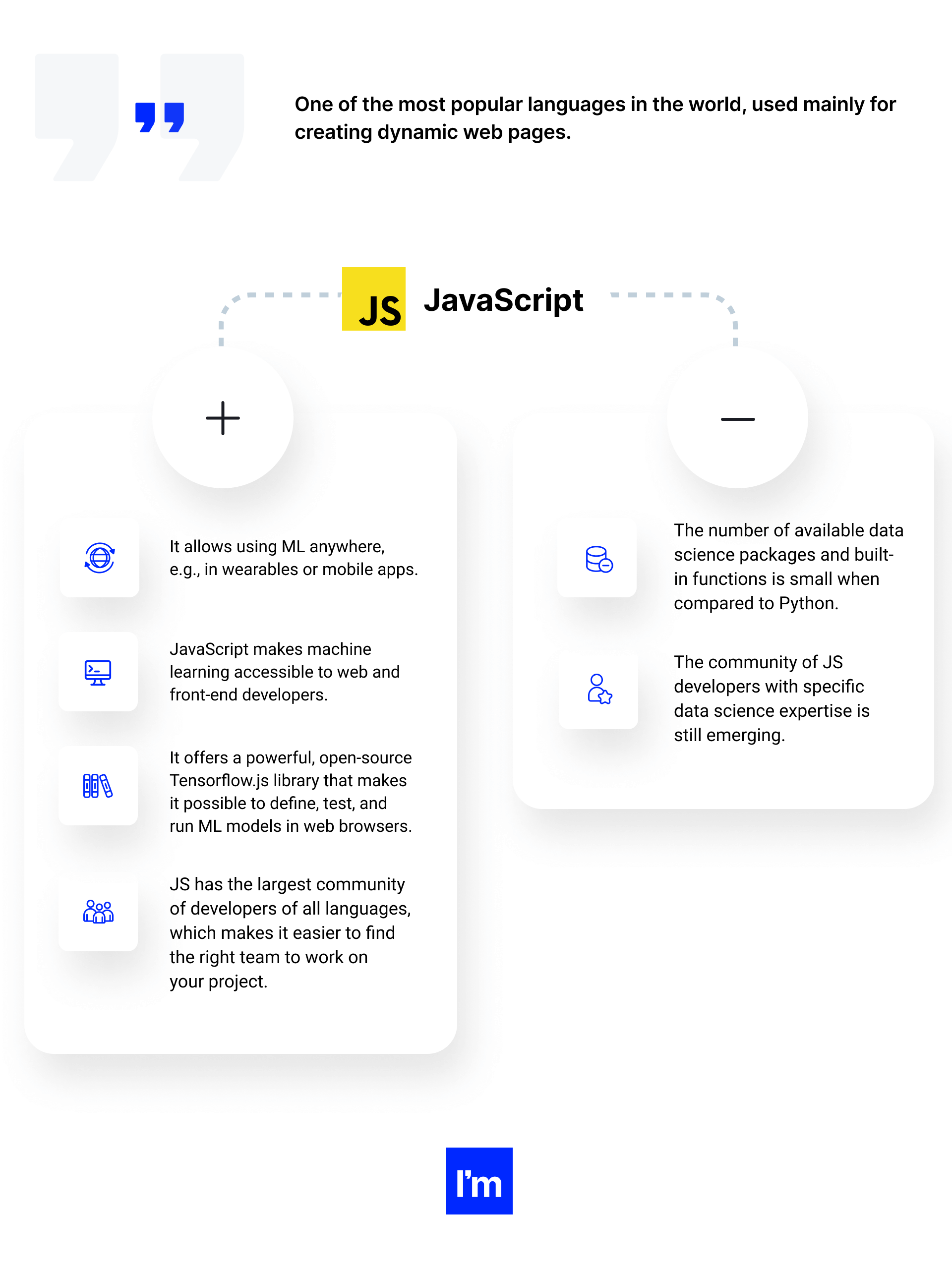
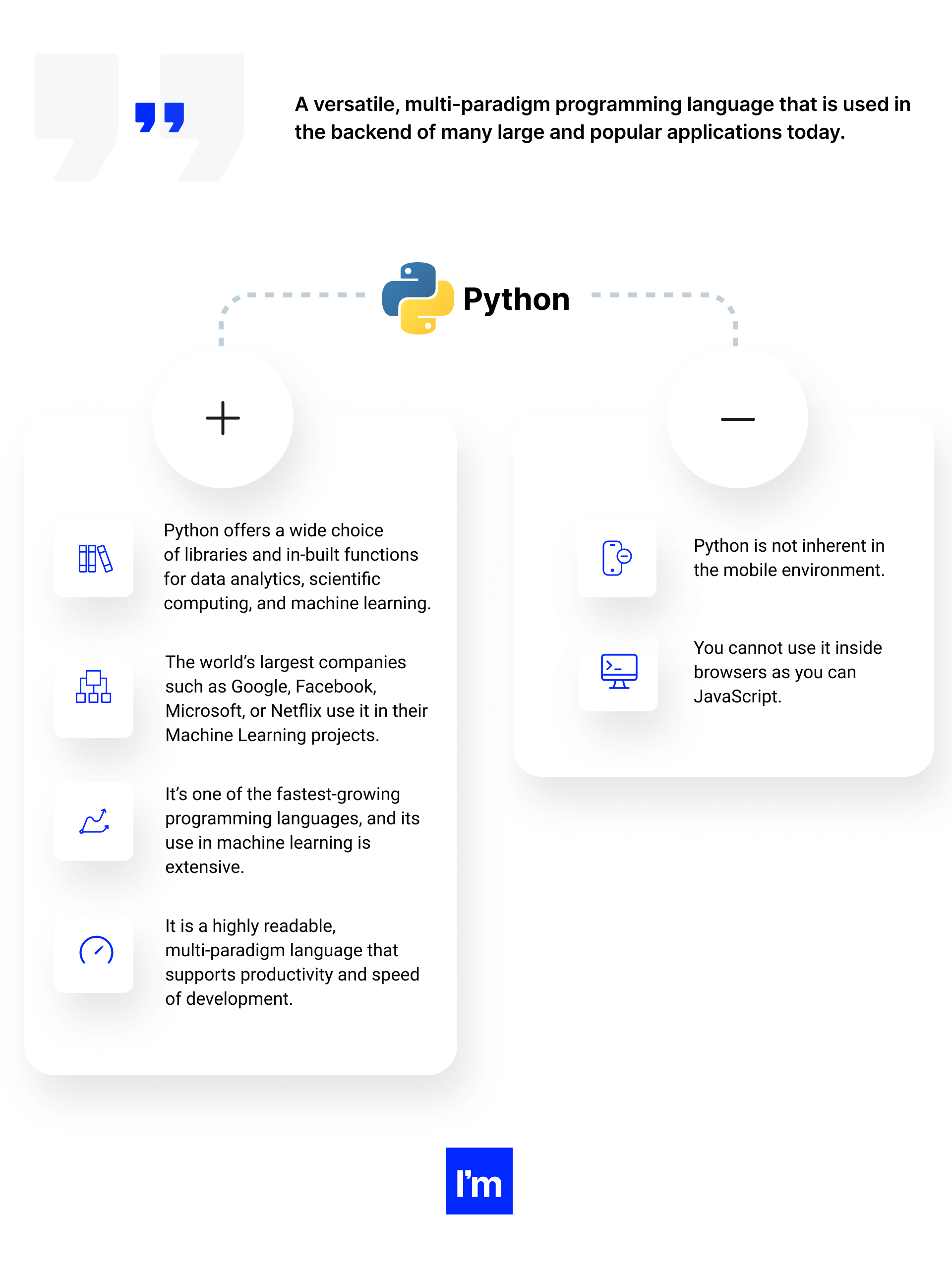
Which one is better for machine learning? Python or JavaScript?
On the surface, Python seems to be the language of choice for most machine learning projects. However, this doesn’t necessarily have to be true in all cases. In machine learning web applications leveraging frontend components like camera inputs, going with JavaScript may turn out more practical.
As always, there are a number of aspects to consider before reaching the final decision. To get support, consult a trusted team of technology experts with previous experience in implementing AI and ML projects in both languages.

Michał Pruciak is a seasoned consultant for tech leaders, known for his exceptional skills in business development and his passion for blending medical technology with cutting-edge advancements. He excels in strategic thinking and critical problem-solving, making him a valuable asset in his field. When he is not working, Michał enjoys watching movies and going for hikes, valuing a balance in his personal life through staying active.
View all author posts
JavaScript: The Definitive Guide For Entrepreneurs and Product Owners
Everything You Need To Know About JS Business Implementation In 2023
Read nowTrending articles
21 Dazzling Examples of Mobile App UI Design to Inspire You in 2023
Michał Pruciak 7 min read
MedTech vs HealthTech vs BioTech: What Are The Differences?
Michał Pruciak 7 min read
10 Business Applications of Neural Network (With Examples!)
Michał Pruciak 4 min read
Best React Native Boilerplates to Use In 2023
Michał Pruciak 6 min read
10 Irresistible Examples of Web Design Best Practices for 2023
Adam Kozłowski 7 min read

Agile Software Development
Rated 4.8 / 5.0 by clients from various industries and locations.
.png?width=1584&name=Python_%20The%20Definitive%20Business%20Guide%20-%20blog%20banner%201584x396%20(1).png)




-1.png)
